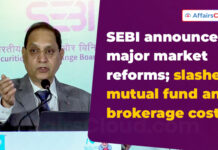 On September 4, 2020, Reserve Bank of India (RBI) specified five financial ratios and sector-specific thresholds for resolution of COVID-19-related stressed assets in 26 sectors on the basis of the recommendations of an expert committee under the chairmanship Kundapur Vaman Kamath, which was formulated by RBI in August 2020 to set a parameters and benchmarks for stressed assets that need rescuing.
On September 4, 2020, Reserve Bank of India (RBI) specified five financial ratios and sector-specific thresholds for resolution of COVID-19-related stressed assets in 26 sectors on the basis of the recommendations of an expert committee under the chairmanship Kundapur Vaman Kamath, which was formulated by RBI in August 2020 to set a parameters and benchmarks for stressed assets that need rescuing.
- These five ratios are: Total outside liabilities/adjusted tangible net worth (TOL/ATNW), total debt/EBITDA, current ratio, debt service coverage ratio (DSCR), average debt service coverage ratio (ADSCR).
- In respect of other sectors where certain ratios have not been specified, the lenders shall make their own assessment keeping in view the “Resolution Framework for COVID-19-related Stress”.
Key Points:
-The 26 sectors specified by the RBI include automobiles, power, tourism, cement, chemicals, gems and jewellery, logistic, mining, manufacturing, real estate, and shipping among others.
-TOL/ATNW has to be maintained as per the resolution plan by March 31, 2022 and on an ongoing basis thereafter.”
-The current ratio and DSCR in all cases shall be 1.0 and above, and ADSCR shall be 1.2 and above.
RBI sets debt recast rules for Covid-19-hit Indian companies
The central bank has allowed banks to alter the terms of loans for cash-strapped borrowers hit by the fallout of the coronavirus pandemic, including longer repayment times and an extended freeze on repayments. Under the new measures, lenders don’t have to classify restructured loans as bad debt for up to two years.
- In August 2020, RBI gave lenders the power to restructure certain loans, replacing a six-month moratorium that ended on Aug. 31. Only loans that were performing as of March will be eligible for restructuring.
Definitions of Key Ratios:
TOL / Adjusted TNW– It is an addition of long-term debt, short term debt, current liabilities and provisions along with deferred tax liability divided by tangible net worth net of the investments and loans in the group and outside entities.
Total Debt / EBIDTA– It is an addition of short term and long-term debt divided by addition of profit before tax, interest and finance charges along with depreciation and amortisation.
Current Ratio– Current assets divided by current liabilities.
Debt Service Coverage Ratio (DSCR)– For the relevant year addition of net cash accruals along with interest and finance charges divided by addition of current portion of long term debt with interest and finance charges.
Average Debt Service Coverage Ratio (ADSCR)– Over the period of the loan addition of net cash accruals along with interest and finance charges divided by addition of current portion of long term debt with interest and finance charges.
Recent Related News:
On August 13, 2020, RBI revised the guidelines applicable for Core Investment Companies (CICs) by making guidelines stricter for CICs by mandating more disclosures, better risk management and a simpler group structure w.e.f. August 13, 2020. The existing entities have been given time till 31 March 2023 to reorganize their business structure.
About Reserve Bank of India (RBI):
Headquarters– Mumbai, Maharashtra
Formation– 1 April 1935
Governor– Shaktikanta Das
Deputy Governors– 4 (Bibhu Prasad Kanungo, Mahesh Kumar Jain, Michael Debabrata Patra, one is yet to be appointed).




